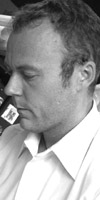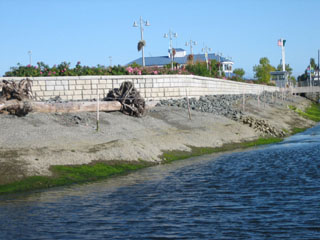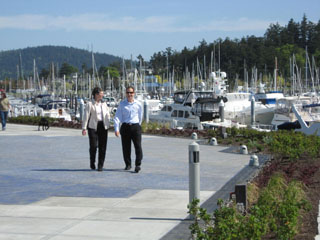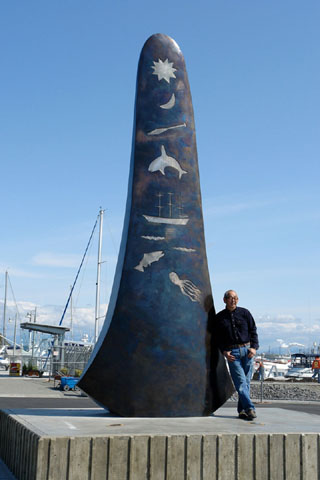
DJC.COM
September 25, 2008
Competing goals drive Anacortes marina project
HBB Landscape Architecture

Koonts
|
Public access and economic development have taken a larger role in the overall mission of Northwest ports in the last few years. These goals have encouraged a greater awareness and public scrutiny of the ports’ waterfront environment.
With the public demand for better water quality, improved shoreline environments and protection of the near-shore habitat, port authorities across the greater Puget Sound region have had to further refine their mission to include stewardship of their waterfront environments.
The mission statement for the Port of Anacortes, for example, includes being a “steward of the public resources” and protecting quality of life as an “appropriate balance among economical, social and environmental elements.”

Photo courtesy Port of Anacortes A soil cleanup project restored a half-mile section of shoreline habitat at Cap Sante Boat Haven. Work included planting near-shore vegetation and installing drift logs and root wads. |
Balancing all these elements does not come easily, but the port’s redevelopment of Cap Sante Boat Haven offers a model for creating a waterfront attraction that generates jobs, helps businesses and improves the shoreline environment.
Marina improvements
By leveraging several grants from state agencies, the Port of Anacortes was able to pursue an integrated approach to removing contaminates, restoring aquatic habitat and creating new, improved public facilities along the waterfront. Initial plans, called Focus Fidalgo, coordinated five different cleanup efforts on port property.
The port obtained a grant to remove 13,000 tons of contaminated soil from past fuel leaks in the upland areas of the Boat Haven.
| Cap Sante Boat Haven |
|
Port of Anacortes Landscape architect: HBB Landscape Architecture General contractor (upland): Callen Construction Co. Environmental contractor (shoreline): Clearcreek Contractors Civil engineer: KPFF Consulting Engineers and Sound Development Group Electrical engineer: j Omega Engineering Environmental engineer: GeoEngineers Art: Gerard Tsutakawa |
The soil cleanup project also restored a half-mile section of shoreline habitat within the marina by planting near-shore vegetation and installing large woody debris in the form of drift logs and root wads. This provided a foundation for the first phase of public access improvements.
A second grant through the state’s Aquatic Land Enhancement Account allowed the port to strengthen the pedestrian waterfront access at the Boat Haven. A 2,100-foot stretch of shoreline esplanade was improved, with a new pedestrian connection through the commercial area of the marina that created a continuous walkway from Rotary Park, at the marina’s northeast corner, to Seafarers’ Memorial Park, at its southeast corner.
Esplanade improvements included several pedestrian viewpoints, including benches, landscaping, and custom light poles with banners and hanging baskets. An enhanced section of the esplanade created an outdoor room that contains specialty glass aggregate paving, tables and chairs, and concrete bench seats that frame the space and display art tiles created by Anacortes youth.
Interpretive signs along the esplanade describe the local marine life, the history of the area, and the fuel and oil refinement process. The aquatic vegetation and beach area created under the soil cleanup project is separated from the uplands by a decorative block retaining wall bordered by a 5-foot landscape buffer that contrasts with the hard edge of the esplanade.
Public art has also played an important role in the development of the marina. The port sought to add artistic elements into all stages of the upland projects.
The 20-foot-high centerpiece, located at the central pier entry, is a bronze and stainless-steel sculpture by Seattle artist Gerard Tsutakawa. The design incorporates silhouettes of marine images to welcome visitors from both land and sea to the marina.
Environmental recognition

Photo courtesy Port of Anacortes Improvements to a 2,100-foot stretch of the shoreline esplanade included a new pedestrian connection through the commercial area of the marina. |
Cap Sante Boat Haven was the first cleanup project in Fidalgo Bay under Gov. Chris Gregoire’s Puget Sound Initiative. The project won the port recognition by the Clean Marina Washington program as a certified “clean marina” for its commitment, innovation and regional leadership. (Clean Marina Washington is a partnership between marine businesses, government agencies and environmental advocates.)
Cap Sante Boat Haven joins a network of 34 marinas working to protect waterways that are currently certified in Washington state, and there are hundreds more marinas in similar programs around the country.
The Port of Anacortes also won an award from the American Association of Port Authorities for the Fidalgo Bay eelgrass mitigation project. This award is one of four given in the “environmental improvement awards” category.
The project was constructed as mitigation for impacts to eelgrass resulting from dredging the Dakota Creek Industries ship basins for Project Pier 1. The mitigation project is unique because it is large enough to allow for advance compensation for impacts to eelgrass that could result from future port dredging projects, and is an important first step to allow the port some additional flexibility in implementing the overall Focus Fidalgo plan.
This type of recognition highlights the effort and planning required to balance the often competing needs at port facilities.

Photo courtesy Steve Berentson Seattle artist Gerard Tsutakawa stands next to his 20-foot bronze and stainless-steel sculpture “Annie Curtis” at the central pier entry. Silhouettes of marine images welcome visitors to the marina. |
By creating an inviting public space while restoring and enhancing the natural shoreline, the port has been able to significantly increase the potential uses of the marina and showcase its achievements to the larger Puget Sound region.
The design is a small-scale testament to the larger efforts in balancing economics, public access and the environment, and a showcase for project development among ports nationwide. As redevelopment proceeds, the Port of Anacortes hopes to continue to integrate habitat restoration, environmental stewardship and public access within the Boat Haven, bringing economic vitality and improved quality of life to the community.
Dean W. Koonts is a senior associate at HBB Landscape Architecture, where he leads many large-scale projects throughout the Puget Sound area.
Other Stories:
- Put mixed uses where they belong — by the water
- 5 principles for renewing Seattle’s waterfront
- Group efforts make for better shorelines
- Seattle’s waterfront a showcase of lost opportunities
- Redevelopment: fraught with challenges, but worth the plunge
- Great civic developments need private know-how
Copyright ©2009 Seattle Daily Journal and DJC.COM.
Comments? Questions? Contact us.